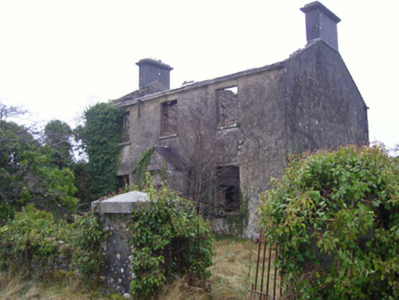Survey Data
Reg No
31307305
Rating
Regional
Categories of Special Interest
Architectural, Historical, Scientific, Social
Previous Name
Kilmovee Constabulary Barrack
Original Use
Garda station/constabulary barracks
Date
1870 - 1875
Coordinates
153740, 294114
Date Recorded
16/01/2013
Date Updated
--/--/--
Description
Detached three-bay two-storey constabulary barrack, designed 1873; built 1873; opened 1874, on a T-shaped plan centred on single-bay single-storey gabled advanced porch to ground floor. Occupied, 1901; 1911. Attacked, 1921. Reconstructed, 1926, to accommodate alternative use. Closed, 1956. Now in ruins. Pitched slate roof now missing with rendered chimney stacks having ogee-detailed stringcourses below capping supporting yellow terracotta pots, and remains of cast-iron rainwater goods on cut-limestone eaves retaining cast-iron downpipes; pitched (gabled) slate roof (porch) with clay ridge tiles. Part ivy-covered rendered walls. Square-headed central door opening in camber-headed recess with benchmark-inscribed step threshold, and concealed dressings with no fittings surviving. Square-headed window openings with cut-limestone sills, and concealed red brick block-and-start surrounds framing remains of six-over-six timber sash windows. Interior in ruins. Set in unkempt grounds with tooled limestone ashlar piers to perimeter having cut-limestone shallow pyramidal capping supporting wrought iron double gates.
Appraisal
A constabulary barrack erected to designs examined (1873) by Enoch Trevor Owen (c.1833-81), Assistant Architect to the Board of Public Works (appointed 1863), representing an important component of the later nineteenth-century built heritage of Kilmovee with the architectural value of the composition, one recalling the contemporary Kinnewry Constabulary Barrack (1873-4), Kinnewry (see 31309901), confirmed by such attributes as the compact rectilinear plan form centred on a windbreak-like porch; and the very slight diminishing in scale of the openings on each floor producing a feint graduated visual impression. Although reduced to ruins following a prolonged period of neglect, the form and massing survive intact together with remnants of the original fabric, thus upholding some of the character or integrity of a constabulary barrack making a picturesque, if increasingly forlorn visual statement in a sylvan setting: meanwhile, a discreet benchmark remains of additional interest for the connections with cartography and the preparation of maps by the Ordnance Survey (established 1824).

